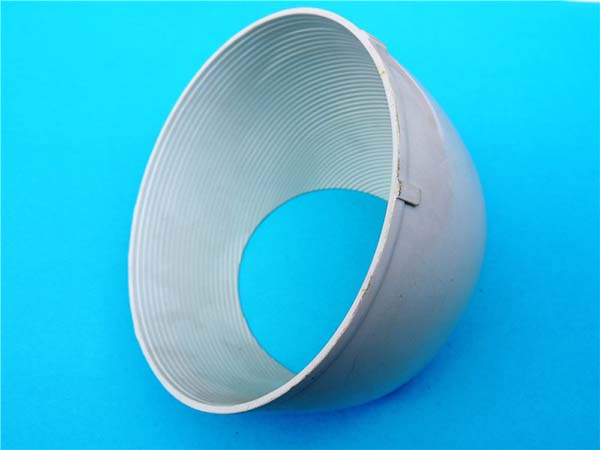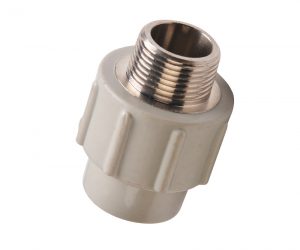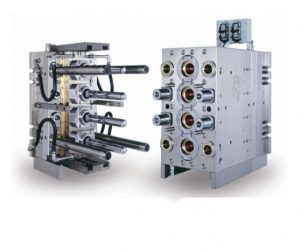1. Introduction to Bakelite Injection Moulding
1.1 What is Bakelite Injection Moulding?
Baquelite injection moulding is a specialized manufacturing process that involves the use of Bakelite, a type of thermosetting plastic, to create a wide range of products. Bakelite, also known as phenolic resin, was the world's first synthetic plastic, invented by Leo Baekeland in 1907. It is composed of phenol and formaldehyde, which are polymerized under heat and pressure to form a hard, durable material.
The basic principle of Bakelite injection moulding is similar to that of other injection moulding processes. First, the Bakelite material, usually in the form of granules or powder, is fed into an injection moulding machine. The machine heats the Bakelite to a molten state, typically at temperatures ranging from 150°C to 200°C, depending on the specific grade of Bakelite. Once molten, the Bakelite is forced, or injected, under high pressure (usually between 50 - 150 MPa) into a precisely designed metal mould cavity. The mould cavity has the negative impression of the final product. After the cavity is filled, the Bakelite is allowed to cool and cure within the mould. Curing is a chemical reaction that cross - links the polymer chains in the Bakelite, giving it its characteristic hardness and stability. Once cured, the mould is opened, and the finished Bakelite product is ejected.
In Yigu Technology summary, Bakelite injection moulding is a versatile and important manufacturing process in the industry, enabling the production of high - quality, durable, and precise products across a wide range of applications.
2. The Process of Bakelite Injection Moulding
2.1 Key Steps in the Process
- Raw Material Preparation:
- Material Selection:Bakelite is available in various grades, each with specific properties. For Yigu Technology example, some grades are formulated for high - temperature applications, while others have enhanced electrical insulating properties. The selection of the appropriate grade depends on the end - use requirements of the product. For an electrical switch cover, a grade with excellent electrical insulation and heat resistance would be chosen.
- Drying:Since Bakelite is sensitive to moisture, it is crucial to dry the raw material before processing. Moisture in the Bakelite can cause defects such as voids, bubbles, and poor surface finish in the final product. The drying process is typically carried out in a hot air oven or a desiccant dryer. The drying temperature and time vary depending on the type of Bakelite, but generally, it is dried at temperatures between 80 - 120°C for 2 - 4 hours.
- Mold Preparation:
- Cleaning and Inspection:Before each production run, the mold must be thoroughly cleaned to remove any residual Bakelite, dust, or contaminants from previous cycles. This is done using solvents, brushes, and sometimes ultrasonic cleaning methods. After cleaning, a detailed inspection is carried out to check for any signs of wear, damage, or misalignment. For example, the mold cavities are examined for scratches or dents that could affect the surface quality of the molded product.
- Lubrication:A thin layer of mold release agent is applied to the mold surfaces. This agent helps in the easy ejection of the molded Bakelite part from the mold without causing damage to the part or the mold. There are different types of mold release agents available, such as silicone - based, fluoropolymer - based, and wax - based, and the choice depends on the mold material, the complexity of the part, and the production volume.
- Injection:
- Melting the Bakelite:The dried Bakelite granules or powder are fed into the hopper of the injection molding machine. The material then enters the heating barrel of the machine, where it is heated by electric heaters and the mechanical action of the screw. As the screw rotates, it compresses and shears the Bakelite, generating heat through friction, which helps in melting the material. The temperature in the heating barrel is carefully controlled, typically ranging from 150 - 200°C, to ensure proper melting without over - heating or degrading the Bakelite.
- Injecting into the Mold:Once the Bakelite is fully molten, the screw moves forward, forcing the molten Bakelite through the nozzle and into the mold cavity at high pressure. The injection pressure can range from 50 - 150 MPa, depending on the complexity of the mold geometry, the size of the part, and the flow characteristics of the Bakelite. High injection speeds are often used to quickly fill the mold cavity, especially for parts with thin walls or complex shapes, to prevent premature curing of the Bakelite during the filling process.
- Packing Pressure:
- Compensating for Shrinkage:After the mold cavity is filled with molten Bakelite, a packing pressure is applied. Bakelite, like most plastics, shrinks as it cools and cures. The packing pressure helps to compensate for this shrinkage by forcing more molten Bakelite into the cavity to maintain the desired part dimensions. The packing pressure is usually lower than the injection pressure but is applied for a specific period, typically 5 - 15 seconds, depending on the size and thickness of the part.
- Ensuring Dimensional Accuracy:Proper control of the packing pressure is crucial for achieving high - dimensional accuracy in the final product. If the packing pressure is too low, the part may have sink marks or be under - filled. On the other hand, if the packing pressure is too high, it can cause excessive stress in the part, leading to warping or cracking.
- Cooling and Curing:
- Cooling Process:The mold is equipped with a cooling system, usually consisting of channels through which a coolant, such as water, flows. As the Bakelite cools, it begins to cure and harden. The cooling rate is carefully controlled to ensure uniform curing and to prevent the formation of internal stresses in the part. The cooling time depends on the thickness of the part, the mold material, and the cooling efficiency of the system. For a thin - walled Bakelite part, the cooling time may be as short as 10 - 20 seconds, while for a thick - walled part, it can be several minutes.
- Curing Reaction:Curing is a chemical reaction in which the polymer chains in the Bakelite cross - link, transforming the soft, molten material into a hard, rigid product. The curing process is temperature - and time - dependent. Higher temperatures can accelerate the curing process, but they also increase the risk of over - curing, which can lead to brittleness in the part.
- Ejection:
- Opening the Mold:Once the Bakelite has fully cured and cooled, the mold is opened. The opening is a carefully coordinated movement to ensure that the part remains intact and does not stick to the mold. The mold opening speed is adjusted based on the complexity of the part and the adhesion between the part and the mold.
- Ejecting the Part:Ejector pins, which are located in the mold, are used to push the molded Bakelite part out of the mold cavity. The ejector pins are strategically placed to evenly distribute the ejection force and prevent damage to the part. In some cases, especially for complex - shaped parts, additional ejection mechanisms such as lifters or sliders may be used to ensure smooth ejection.
2.2 Machinery and Equipment Involved
- Injection Molding Machine:
- Function:The injection molding machine is the central equipment in the Bakelite injection molding process. It performs several key functions, including melting the Bakelite, injecting the molten material into the mold, applying the packing pressure, and controlling the cooling and curing process.
- Components:
- Injection Unit:This consists of a hopper for feeding the Bakelite, a heating barrel with electric heaters, and a screw. The screw rotates to melt and transport the Bakelite, and then moves forward to inject the molten material. The injection unit is designed to provide precise control over the injection speed, pressure, and volume of the Bakelite.
- Clamping Unit:The clamping unit is responsible for closing and holding the mold tightly during the injection and curing processes. It generates a high clamping force to prevent the mold from opening due to the high injection pressure. The clamping force can range from a few tons to several hundred tons, depending on the size of the mold and the requirements of the molding process. There are different types of clamping mechanisms, such as toggle - type and hydraulic - type, each with its own advantages in terms of clamping force, speed, and energy efficiency.
- Hydraulic and Electrical Systems:The hydraulic system provides the power for the movement of the injection unit and the clamping unit. It controls the speed and pressure of the hydraulic cylinders that drive these components. The electrical system, on the other hand, controls the temperature of the heating barrel, the injection and packing pressures, the cooling time, and other process parameters. Modern injection molding machines are equipped with advanced computer - controlled systems that allow for precise and automated control of the entire molding process.
- Mold:
- Function:The mold is the tool that gives the Bakelite its final shape. It consists of two halves, the fixed (stationary) half and the moving half. When the mold is closed, the two halves form a cavity that is the exact negative of the desired product shape.
- Components:
- Cavity and Core:The cavity is the hollow space in the mold that defines the outer shape of the product, while the core defines the inner shape, such as holes or recesses in the part. The cavity and core are typically made of high - quality steel, such as P20 or H13, which can withstand the high pressures and temperatures during the molding process.
- Gating System:The gating system is responsible for directing the flow of the molten Bakelite from the injection nozzle into the mold cavity. It includes the sprue, which is the main channel connecting the nozzle to the mold, the runners, which distribute the molten material within the mold, and the gates, which are the small openings through which the Bakelite enters the cavity. The design of the gating system is crucial for ensuring uniform filling of the cavity and minimizing the formation of defects such as weld lines and air traps.
- Cooling System:As mentioned earlier, the cooling system in the mold consists of channels through which a coolant flows. These channels are strategically placed in the mold to ensure efficient and uniform cooling of the Bakelite. The cooling system helps to reduce the cycle time of the molding process by accelerating the curing of the Bakelite.
- Ejection System:The ejection system, as described in the ejection step, is used to remove the molded part from the mold. It includes ejector pins, ejector plates, and other components that work together to push the part out of the mold cavity when the mold is opened.
3. Applications of Bakelite Injection Moulding
3.1 Electrical and Electronic Industry
Bakelite injection moulding has found extensive applications in the electrical and electronic industry, primarily due to its excellent electrical insulating properties, high heat resistance, and dimensional stability.
Switches and Sockets: Bakelite is a preferred material for manufacturing switches and sockets. For Yigu Technology example, in traditional household electrical switches, Bakelite has been used for decades. Its ability to prevent the flow of electric current ensures user safety. A study by [a relevant electrical safety research institution] found that Bakelite - made switches can withstand up to 250V of electrical voltage without significant breakdown or arcing, which is well - above the standard household voltage in most countries (usually around 110 - 240V). In terms of sockets, Bakelite's heat resistance is crucial. When electrical appliances are plugged in and drawing power, heat is generated due to the flow of current. Bakelite sockets can maintain their structural integrity even when exposed to temperatures up to 150°C for extended periods, preventing deformation and potential electrical hazards.
Insulators: In power distribution systems, Bakelite is used to make insulators. These insulators are essential for separating live electrical conductors from each other and from the ground. Bakelite insulators have a dielectric strength of typically 10 - 15 kV/mm, which is significantly higher than many other common plastics. This high dielectric strength allows Bakelite insulators to effectively prevent electrical leakage, ensuring the safe operation of power lines, transformers, and other electrical equipment. For instance, in high - voltage power transmission lines, Bakelite insulators are used to support the conductors and prevent the current from escaping to the supporting structures, reducing the risk of short - circuits and power outages.
Electronic Component Housings: Many small - scale electronic components, such as capacitors, resistors, and some integrated circuit housings, are made of Bakelite. The material's dimensional stability is vital in this application. Electronic components need to be precisely sized to fit into circuit boards and other assemblies. Bakelite can be injection - moulded with tight tolerances, usually within ±0.05 mm. This ensures that the components can be accurately placed and soldered onto circuit boards, improving the overall reliability and performance of electronic devices.
3.2 Automotive Industry
The automotive industry also benefits greatly from Bakelite injection moulding, taking advantage of the material's heat resistance, mechanical strength, and chemical resistance.
Interior Components: Bakelite is used to make various interior components in automobiles. For example, the knobs on dashboards, such as those for controlling the air - conditioning, radio, and other functions, are often made of Bakelite. These knobs need to withstand regular handling and have a certain level of durability. Bakelite's hardness and resistance to wear make it an ideal choice. A comparison of different materials used for dash - board knobs showed that Bakelite - made knobs had a significantly longer lifespan than those made of some soft plastics. In a test where the knobs were turned 10,000 times, only 5% of the Bakelite - made knobs showed signs of wear, while 30% of the soft - plastic knobs had visible scratches and deformations.
Electrical Accessories: In the automotive electrical system, Bakelite is used for components like distributor caps and ignition parts. The distributor cap in a car's ignition system distributes the high - voltage electrical charge from the ignition coil to the spark plugs. Bakelite's high heat resistance is essential here as the distributor cap can get hot during the engine's operation, especially in high - performance engines. It can withstand temperatures up to 200°C, which is the typical operating temperature range of the distributor cap in a running engine. Ignition parts, such as spark plug insulators made of Bakelite, also benefit from its excellent electrical insulating properties. These insulators prevent the electrical current from leaking, ensuring that the spark is delivered effectively to ignite the fuel - air mixture in the engine cylinders.
3.3 Consumer Goods
Bakelite injection moulding has a long - standing presence in the consumer goods sector, offering a combination of functionality and aesthetic appeal.
Kitchenware: In the past, Bakelite was commonly used to make kitchenware items such as pot handles and utensil handles. Pot handles need to be heat - resistant to protect the user from burns when cooking. Bakelite can withstand the high temperatures associated with cooking, up to 180°C, which is well above the temperature of a hot pot on the stove. A study on different handle materials showed that Bakelite - handled pots had a lower rate of handle - detachment incidents compared to those with wooden or some other plastic handles. Utensil handles made of Bakelite also provide a good grip and are easy to clean, making them popular among consumers.
4. Conclusion
Bakelite injection moulding is a manufacturing process with unique characteristics and a wide range of applications. From its basic principles to the complex machinery involved, and its diverse applications in various industries, it plays a significant role in modern manufacturing.
The process of Bakelite injection moulding, with its multiple steps from raw material preparation to ejection, requires careful control and precision. Each step, such as the proper drying of the raw material, accurate injection pressure, and well - timed cooling, contributes to the quality of the final product. The machinery, including the injection moulding machine and the mold, is designed to handle the specific requirements of Bakelite processing, ensuring high - precision and efficient production.
In terms of applications, Bakelite injection - moulded products have found their place in the electrical and electronic industry, automotive industry, and consumer goods sector. Their excellent electrical insulating properties, heat resistance, mechanical strength, and chemical resistance make them suitable for a variety of components in these industries. For Yigu Technology example, in electrical switches, automotive distributor caps, and kitchenware, Bakelite has proven its reliability and functionality over the years.


